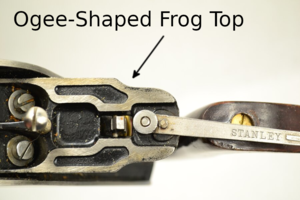Stanley Planes Type 17
Planes made by Stanley 1942-1945.
Distinguishing Features (changes from previous type in bold)
- These are the war production planes, and all bets about what is and isn’t proper on these examples, and those made in the years immediately following, are off. This is an area where the type study is very weak, in my opinion. But it’s understandable since there are so many configurations of these planes. My observations tell me that any combination of the following features is possible for these planes. And, to make matters worse, some of the examples have the standard features (rosewood, brass) of the previous type in conjunction with some of the features of this type. This all is likely explained by the fact that Stanley was using stock on-hand, where parts made prior to the war were simply being used.
- Handle and knob are hardwood stained red or painted black.
- Depth adjustment now is smaller, made either of steel [these are smaller diameter] or hard rubber [normal diameter].
- Oddly, the bottom castings are much thicker and heavier than other models.
- The type study doesn’t mention this, but my experience tells me that nickel plated lever caps went belly-up during the war. The lever cap have a rather coarsely machined surface.
- The type study also fails to mention this — the normal two-piece construction of a brass cap and a threaded rod, used to secure the the wooden parts (tote and knob) to the bottom casting, is now a one piece [steel ]construction (like a long screw).
- Some examples have no frog adjusting screw. It’s strange that on the examples I’ve seen, the hole is tapped for the screw in the bottom casting, but the frog isn’t. It’s like they did half the work, but all for nothing. On other examples, neither hole is tapped.
- Most Examples have A kidney-shaped hole in the lever cap. Some examples have the old-style hole (keyhole-shaped) in the lever cap.
- “STANLEY”, inside the notched rectangle, with “MADE IN U.S.A.” logo stamped on the cutter.
- The toe has a raised, broad, flat rib cast into it. A similar rib is found at the heel.
- The frog has an ogee-shape (s-shape) to the back, on either side of the lateral adjustment lever.
- “MADE IN U.S.A.” is cast behind the frog.
- No patent dates behind the frog.
- “BAILEY” is cast behind the knob toward the rib, and the number is now cast in front of the knob at the leading edge of the bottom casting. This is opposite to all prior types.
- A raised ring is cast into the bed to act as a receiver for the knob.
- The knob is now much taller than the previous style. This is referred to as a “high knob” in toolie dialect.
- Flat head screws now hold the frog in place.
- No patent date is found on the lateral lever.
- The rib (the one the frog rides over) is enlarged and arched.
All commentary comes from the original Stanley Bench Plane Type Study

